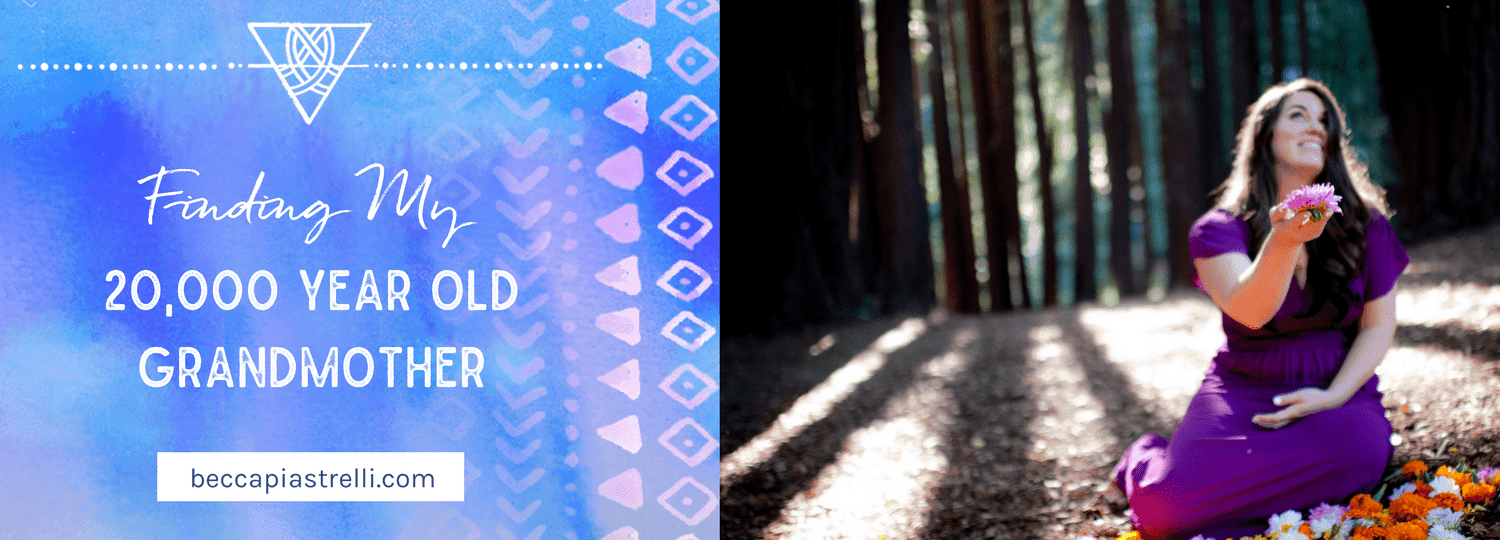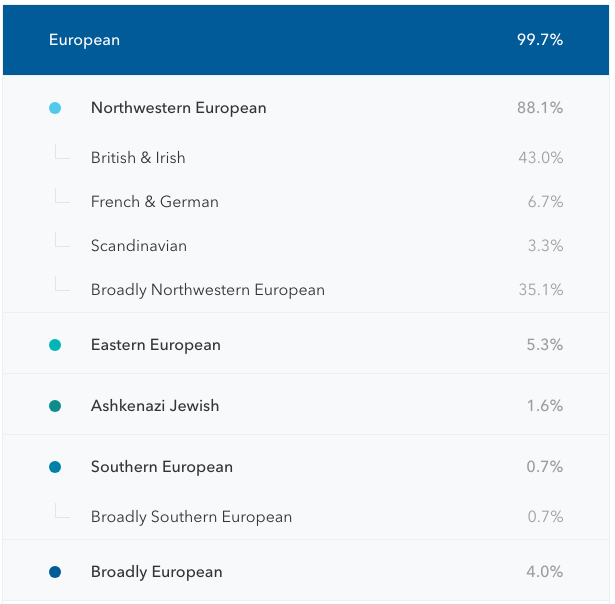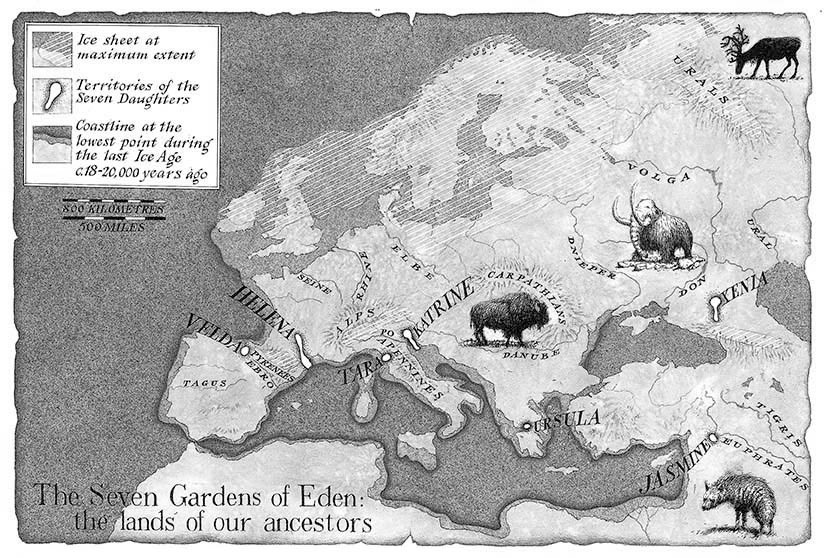
As much as I can feel like I was born in the wrong era and find myself drawn to earlier times of cobblestone streets or ancient temples, I am extremely grateful for technology right now.
Let me explain.
Not only is modern technology connecting us in this very moment through underground cables and wireless routers and efficiently powered smartphones…
Not only is modern technology making it possible for you to google something on the web and go down a rabbit hole to eventually find that life-changing blog post or informative article or long lost friend you thought you’d never see again…
Modern technology has made it so I have been able to connect with Helena—the original mother of my lineage—who walked this earth a mere 20,000 years ago.
Cue tears-in-my-eyes-jaw-on-the-floor when I found that out.
Here’s how it happened…
I began this year with a desire to connect more deeply with my own ancestry.
As someone who has always been drawn to ancient cultures and yearned for a deeper connection to spiritual traditions, I started to become aware of many women who were like me (of European descent) that were teetering on the edge of appropriating other cultural traditions. I believe this comes from a desire to feel connected to something deeper and bigger than ourselves but can result in further perpetuating the marginalization of minority groups in this world.
I recognized times in my own life when I was unknowingly appropriating other cultures, and wanted to make a shift. I wanted to honor these cultural traditions as sacred and also come to more deeply understand my own.
Throughout my life, I’ve had little stirrings of knowing around certain cultures.
When I watched Outlander for the first time, I openly wept. The hilly Scottish countryside, the songs, the historical context all felt so deeply real to me.
When Tim and I visited Iceland several years ago, I also couldn’t help but feel so at home wherever we traveled to (which is strange since the conditions are so harsh in that part of the world).
I also felt this sense of familiarity when I traveled to India during my junior year of college and it comes back up whenever I read about the indigenous tribes of the Northeastern states. It perplexes my rational mind, but I believe this to be a connection to my soul lineage – the line of ancestry that I resonate with from the deepest core of my essence. These are the lifeways that I can remember, that I already know, without logical explanation for it.
Through all this realization and exploration, I decided I needed deeper clarity on who my people are and were.
So for the winter holidays, Tim and I gifted each other the ancestry test from 23andMe. We surprised ourselves with how excited we both were to spit in a tube and finally find out what our actual global ancestry was. It took 8 anxious weeks to get our results back.
It turns out, I’m 99.7% European, concentrated mostly in the northwestern regions. Here’s a screenshot of my results:

My results pretty much confirmed what I knew to be true (with a few unexpected data points – like the fact that I am 0.3% Native American and 1.6% Ashkenazi Jewish), but then something very magical happened.
I was sharing my results on Instagram stories and my friend messaged me, asking if I knew who my Clan Mother was. My response was, “No, but tell what that is because my whole body is tingling with intense curiosity!”
She explained that, for people who are primarily of European descent, the DNA they inherit from their mothers can be traced back many thousands of years back to just one woman—the common maternal ancestor for her clan.*
The idea of finding out who my ancestral grandmother was got me googling like crazy, learning about this world of Mitochondrial DNA (or mtDNA).
Here’s a cool fact: Your mtDNA assists your cells in using oxygen. So every time you breathe, you are using the mtDNA of your clan mother.
The moment I read this, the feeling I felt was indescribably palpable. Thanks to modern genetic science, I had the opportunity to connect with my 20,000-year-old Grandmother.
Using my ancestry report from 23andMe, I was able to easily find my maternal DNA Haplogroup which is a long chain of letters and numbers. What’s important, however, is the letter it begins with as there are only seven of them. For me, that letter is H.
Armed with my letter H, I found my way to the work of Oxford genetics professor Bryan Sykes who wrote a book called The Seven Daughters of Eve. In his book, Bryan has taken each of these seven letters (representing each Clan Mother) and given each of them a name and a story.
My clan mother is Helena (Greek for light).
According to Sykes, Helena lived 20,000 years ago at a time when the last Ice Age was at its most severe. In the winter, the Atlantic Ocean froze and pack ice could be found as far south as Bordeaux in France. Britain was still joined to continental Europe by dry land, and what are now the English Midlands, central Wales, and southern Ireland were all buried under ice.
Helena spent her childhood on the shoreline and in the woodlands south of the ice sheets. She would help her mother comb the woods for wild mushrooms and toadstools, or wade into the brackish lagoons searching for oysters. Her father patrolled the woods alone, on the lookout for small deer and other mammals to hunt with handmade spears.
Knowing I am a descendent of Helena brings me a sense of grounded connection—like a tree whose roots go deep into earth for miles and miles—rooting me into a lineage of women that go back thousands of years. It gives me a deeper feeling of purpose—that I am Helena’s legacy.
That she hand-stitched clothes with sinew and pelts to survive through those ice cold winters and birthed her babies in a cave by the river during the annual reindeer migration to 20,000 years later pass on her DNA through the very breath that moves through my lungs brings me to my knees in awe.
So, even though I still wonder what it would have been like to be a medicine woman in ancient Ireland or a parfumier in 18th century France or Nordic warrioress in old Scandinavia, I’m also eternally grateful to be alive here in this moment. To have the ability to connect to Helena and all of her that is within me.
Curious about the other clan mothers? Here they are below:

{image via The Seven Daughters of Eve}
The clan of Ursula (Latin for she-bear)
The clan of Xenia (Greek for hospitable)
The clan of Helena (Greek for light)
The clan of Velda (Scandinavian for ruler)
The clan of Tara (Gaelic for rocky hill)
The clan of Katrine (Greek for pure)
The clan of Jasmine (Persian for flower)
*This is true for all major cultural clusters around the world. Among Native Americans, there were four clan mothers, among Japanese people, there were nine clan mothers, etc. For the purposes of this article, I will be focusing on my own European ancestry but I encourage you to research your own.
Each of us has in our lineage around six billion ancestors (and that’s just from the past 12,000 years). All of those lives existed to create your life. And the ancestors live on in and through us in our blood and bones helping to shape our physical and spiritual descendants. To tap into those who came before us to remember that we belong to a vast and resilient lineage. It helps us see beyond our own selves in this moment. We are a part of a vast web of ancestry that spirals through time.
Now I want to hear from you!
Do you know who your clan mother is? Have you researched your ancestral heritage? What did you find out?
Share in the comments below.